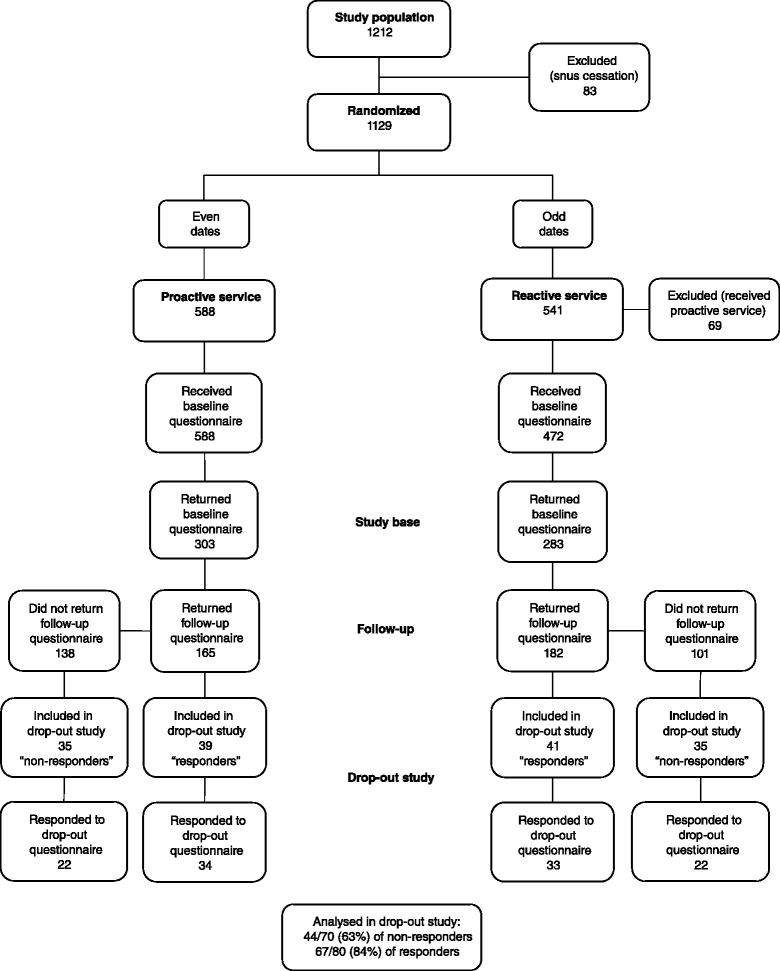Non-responders in a quitline evaluation are more likely to be smokers - a drop-out and long-term follow-up study of the Swedish National Tobacco Quitline
- PMID: 26843854
- PMCID: PMC4739394
- DOI: 10.1186/s12971-016-0070-2
Non-responders in a quitline evaluation are more likely to be smokers - a drop-out and long-term follow-up study of the Swedish National Tobacco Quitline
Abstract
Background: A previous randomized controlled trial (RCT) of the Swedish National Tobacco Quitline detected no significant differences in smoking cessation outcomes between proactive and reactive services at 12-month follow-up. However, the response rate was only 59 % and non-responders were over-represented in the proactive service. We performed a drop-out analysis to assess the smoking status of initial responders and non-responders.
Methods: At 29-48 months after the first call, a postal questionnaire with six questions was sent to 150 random clients from the RCT database, with equal numbers from the proactive and reactive services as well as responders and non-responders at 12-month follow-up. Clients who did not return the questionnaire were contacted by telephone. The outcome measures were point prevalence (PP) and 6-month continuous abstinence (CA), and their associations with response status at 12 months were assessed by logistic regression.
Results: The response rate was 74 % (111/150). Abstinence was significantly higher among initial responders than non-responders (PP 54 % vs. 32 %, p = .023 and CA 49 % vs. 21 %, p = .003). The odds ratios for initial responders vs. initial non-responders were, for PP = 2.5 (95 % CI 1.1-5.6, p = .024), and for CA = 3.7 (95 % CI 1.5-8.9, p = .004), after adjusting for proactive/reactive service.
Conclusions: Non-responders to a 12-month follow-up smoking cessation questionnaire in a quitline setting were more likely to be smokers 1.5-3 years later. We propose a conservative correction factor of 0.8 for self-reported abstinence in telephone-based cessation studies if the response rate is approximately 55-65 %.
Keywords: Effectiveness; Intention-to-treat; Non-response; Per protocol; Proactive; Questionnaire; Reactive; Responder-only analysis; Smoking; Telephone.
Figures
References
-
- World Health Organization . WHO report on the global tobacco epidemic. Geneva: World Health Organization; 2011.
-
- Swedish National Public Health Survey - Health on Equal Terms, 2014 [Internet]. Folkhälsomyndigheten [Public Health Agency of Sweden]. 2015 [cited January 22, 2015]. Available from: http://www.folkhalsomyndigheten.se/amnesomraden/statistik-och-undersokni....
-
- The National Board of Health and Welfare . Register data of the harmful effects of tobacco smoking. Stockholm: Socialstyrelsen [The National Board of Health and Welfare]; 2014.
-
- Fiore MC, Jaén CR, Baker TB, Bailey WC, Benowitz NL, Curry SJ, et al. Treating tobacco use and dependence: 2008 update. Clinical practice guideline. Rockville: U.S. Department of Health and Human Service. Public Health Service; 2008.
-
- Stead LF, Hartmann-Boyce J, Perera R, Lancaster T. Telephone counselling for smoking cessation. Cochrane Database Syst Rev. 2013;8:CD002850. - PubMed
LinkOut - more resources
Full Text Sources
Other Literature Sources
Miscellaneous


